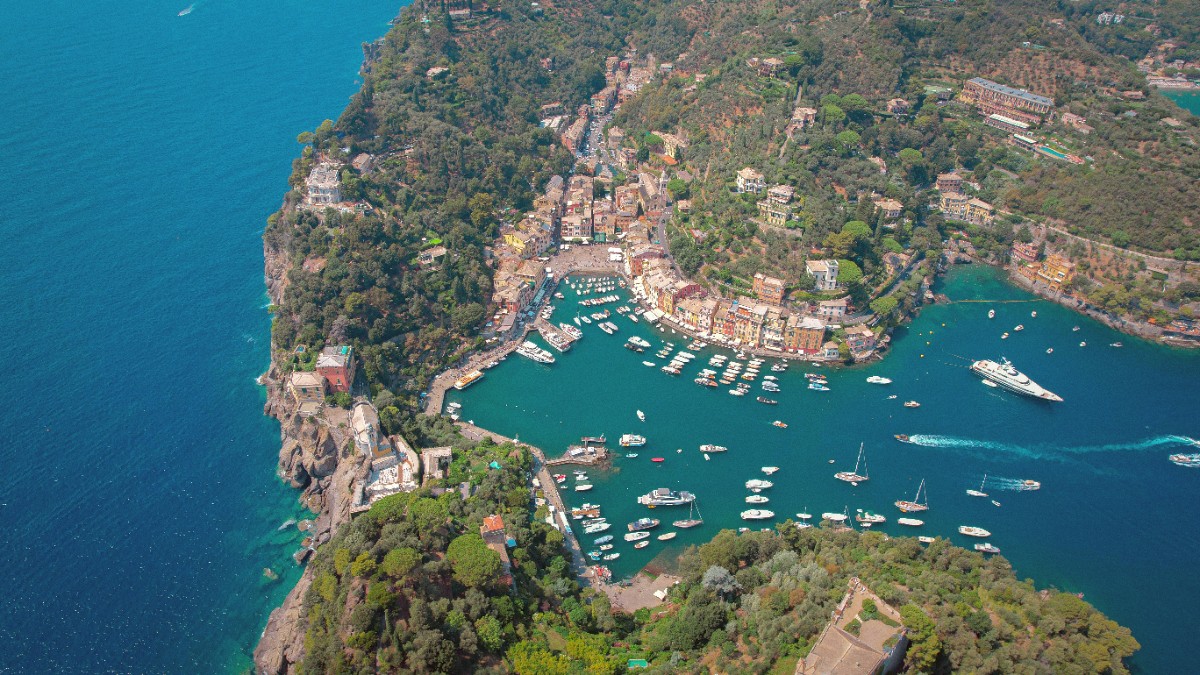
Liguria Piedmont And Valle Daosta, Italy
Superyachts bob alongside traditional fishing boats, and the air carries the scent of salt, citrus, and freshly baked focaccia. Cobblestone paths wind through ancient archways, leading to hidden courtyards and breathtaking viewpoints. This is Portofino, a small Ligurian village that captures the essence of coastal Italian charm and allure. It is a place where every turn presents a scene worthy of a painting, where the pace slows, and natural beauty meets refined elegance.
Your journey to this iconic Italian Riviera gem promises memorable moments, from morning coffees overlooking the sea to sunset strolls along pathways carved into the cliffs.
Portofino sits nestled on the Italian Riviera, within the Liguria region's Metropolitan City of Genoa. Find this captivating village about 36 kilometers (22 miles) southeast of Genoa city center. It occupies a small, sheltered harbor at the base of the Portofino Promontory, a finger of land extending into the Ligurian Sea.
This natural harbor provides a safe haven for boats of all sizes, contributing to the village's long maritime history and its present-day popularity as a yachting destination. The surrounding landscape forms part of the Portofino Regional Natural Park. This protected area shows a diverse environment, moving from dense Mediterranean scrub and aromatic pine forests to carefully terraced olive groves. The park's terrain rises steeply from the sea, forming dramatic cliffs and hidden coves. Beneath the waves, the Marine Protected Area of Portofino extends, preserving an underwater world rich in biodiversity. These protected zones uphold the enduring beauty of Portofino’s natural surroundings, covering both terrestrial and aquatic ecosystems for exploration and enjoyment. Visitors can explore a network of trails through the park, with panoramic views of the coastline and the azure sea.
Portofino's picturesque harbor and colorful buildings
Portofino's story began as a small Roman settlement, known then as Portus Delphini, or "Port of the Dolphin," a name reflecting the abundant marine life once present in its waters. Over centuries, it developed into a quiet fishing village, its inhabitants relying on the sea for sustenance. The natural harbor, deep and protected, soon gained strategic importance, leading to the construction of fortifications. Structures like Castello Brown, a commanding fortress on the hillside, served as defensive strongholds, protecting the village from pirate raids and rival powers. These historical fortifications stand today, offering a glimpse into Portofino’s past as a contested maritime outpost.
The late 19th and early 20th centuries marked a turning point for Portofino. Its untouched scenic beauty, mild climate, and tranquil charm began to attract European aristocracy, artists, and celebrities seeking a serene escape. This period saw its transformation from a humble fishing village into a renowned upscale tourist destination. Villas and exclusive hotels began to dot the hillsides, blending into the landscape. The village’s evolution into a symbol of luxury and exclusivity on the Italian coast is a testament to its enduring appeal. Portofino’s maritime traditions remain a strong thread in its identity, visible in the colorful fishing boats that still tie up in the harbor, and in the fresh seafood forming a cornerstone of its celebrated cuisine. The blend of its ancient past, fishing heritage, and elegant resort status creates the unique character Portofino presents to visitors today.
Known as Portus Delphini, a port frequented by dolphins.
Developed as a quiet community reliant on the sea.
Strategic importance led to structures like Castello Brown for defense.
Attraction for European aristocracy and celebrities.
A symbol of luxury and exclusivity on the Italian coast today.
Portofino, Italy, is a small, exclusive fishing village and resort on the Italian Riviera. It sits within the Liguria region, southeast of Genoa, and is part of a protected natural park that extends into a marine reserve. Expect colorful buildings, luxury yachts, and stunning coastal views.
The village center, focused around the Piazzetta and harbor, offers easy access to charming shops, waterfront restaurants, and cafes. Ascend to Castello Brown and the lighthouse for expansive panoramic views. Outdoor activities like hiking through the Portofino Regional Natural Park or exploring the Marine Protected Area through boating, snorkeling, or diving are popular.
Accommodation within Portofino is limited and expensive, mainly featuring luxury hotels. More budget-friendly options, with frequent transport links, are present in nearby Santa Margherita Ligure or Rapallo. Local cuisine features Ligurian specialties like pesto, focaccia, and fresh seafood.
Consider visiting during the shoulder seasons (April-May or September-October). These months present pleasant weather, fewer crowds, and more moderate prices compared to the peak summer. This timing permits comfortable exploration of the village and surrounding park trails.
Access to Portofino typically involves a scenic ferry ride or a short bus journey from Santa Margherita Ligure, as vehicle access into the village center is restricted and parking is limited. Prepare for walking on cobblestone streets and uphill paths.
Portofino promises a memorable Italian coastal experience, combining natural splendor with an atmosphere of refined elegance.
Discover diverse ecosystems and hiking trails.
Boating, snorkeling, and diving are popular activities.
Ascend to Castello Brown for panoramic vistas.
Vehicle access into the village center is restricted, and parking is limited. The main modes of transport are ferry or bus from Santa Margherita Ligure.